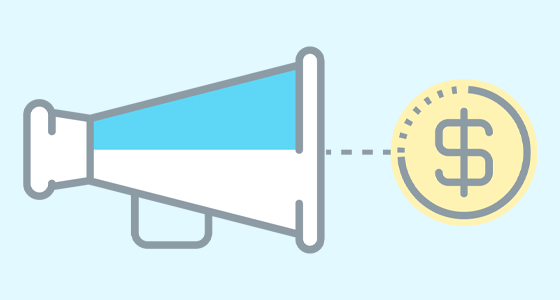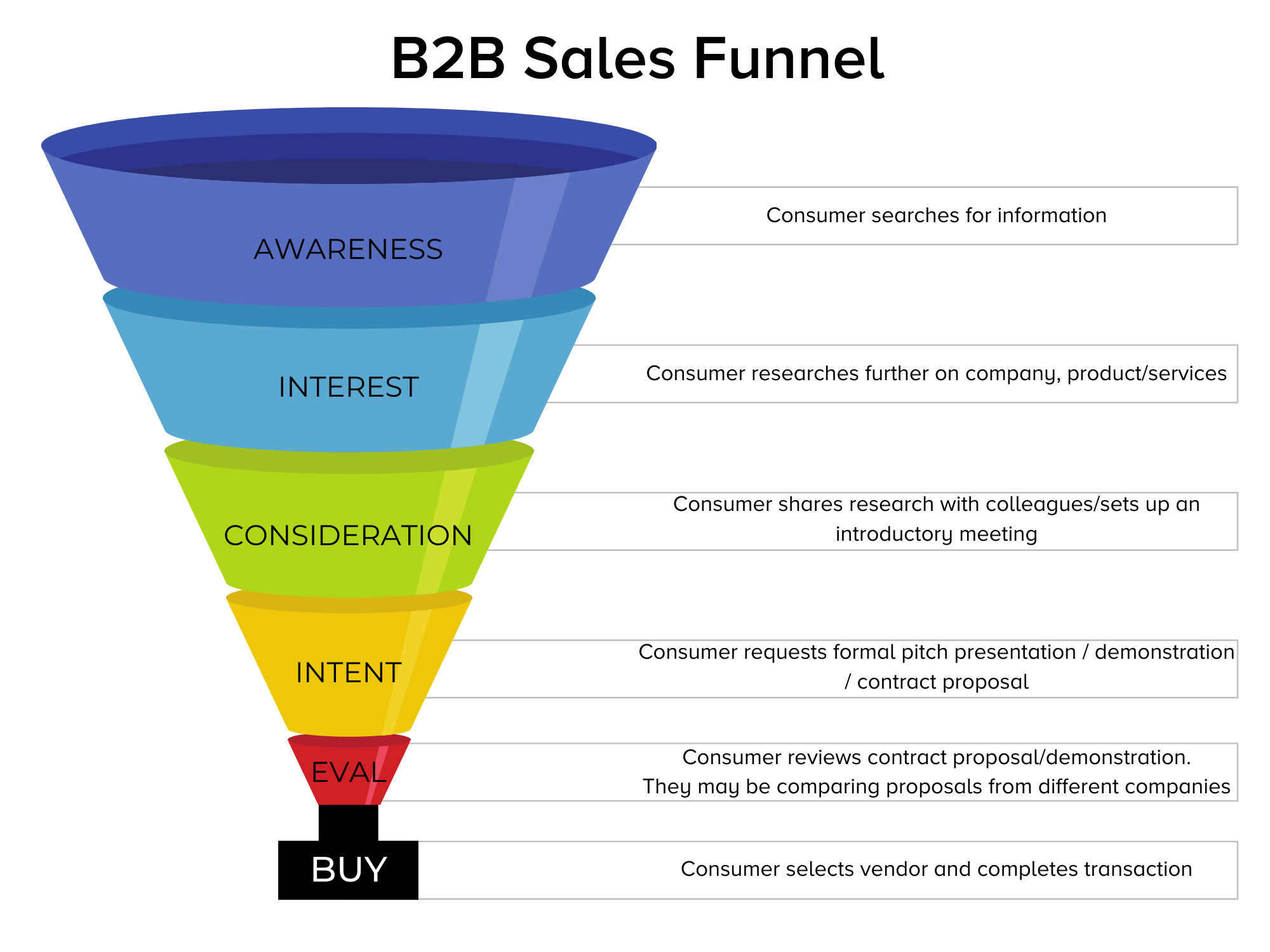
Whether you’re a B2B franchiser, wholesaler, distributor or retailer, the long-term success of your business ultimately depends on the quality of your B2B sales funnel. How do you gauge the current health of your funnel, and where do you go next to optimize performance? Step one is to delve into our Guide to B2B Ecommerce for an overview of the key challenges and opportunities to address. To give you an idea of what level of B2B sales funnel you should be aiming for, here’s a tried and tested structure to emulate, with tips on how to optimize yours for success.
Anatomy of the B2B Sales Funnel
Your B2B customer is on a journey, which starts with them being completely unaware of the existence of your company, and ideally finishes with them championing your business to their network. For simplicity, we call it a funnel, but really we should be aspiring to a loop. No business can afford to wave goodbye to a customer after a single purchase. Profitability lies in bringing them back to the beginning as a repeat customer and delighting them once again. Nevertheless, here are the key stages of the B2B sales funnel:
Awareness
Your customer has a business problem — this much they know. Unfortunately, they might have no idea that you can solve it, or even the name of the solution they are looking for. Their journey will probably start with an online search, so your business needs to have an SEO strategy to rank on page one of the search engine results.
During the Awareness stage, keep a light touch driven by marketing rather than sales, in the form of self-service resources that customers can download (eBooks and whitepapers) or watch (gated video and ‘how to’ content).
Interest
Now the customer can name their problem and is starting to explore the solutions. In sales terms, they are engaged, which means you can start qualifying them as a lead. They’re ready to learn about the solutions to their problem, but are considering a variety of competitor options.
Consideration
Now that the B2B customer is considering the options, it’s time for your marketing team to steal a march on the competition with educational and promotional materials that make your solution impossible to ignore. Don’t sell to your potential buyer yet. Give them answers, guidance and hard data they can take back to their teams.
Intent
As your customer graduates from consuming content to actively searching for answers, they will start requesting information, demos, consultations and more. If the signs are there that your company has made their shortlist, unleash your sales teams.
Evaluation
Behavioral economists would argue that we make an instinctive decision right at the beginning of the process and spend the rest of the time looking for the data to post-rationalize our choice. In B2B sales, there’s a further layer of decision making. Your potential buyer has to justify their selection to other stakeholders in the business, from compliance to treasury. In response, your sales team needs to give them everything they need to demonstrate ROI.
Once the customer reaches the Evaluation stage, shift to personalized gated content that is more targeted to their level of engagement, such as webinars, case studies and demos.
Purchase
Pop the champagne corks and raise the high fives as your sales team closes the deal, possibly after months of nurturing and negotiation. Be aware of celebrating too early, however, considering that 57% of B2B companies in the U.S. report problems and late payments. Encourage and incentivize prompt payment with some of the flexible features such as Net Terms options and Deposit/Balance billing that we use at Zoey.
No sales team wants to lose a customer at the Purchase stage, so be ready with the offer of a free trial, consultation, or on-site demo. The customer has seen the product from every angle. Your sales team needs them to visualize it in their hands.
Referral
An often overlooked stage of the funnel is customer retention and referral, which is surprising when you consider that 84% of B2B decision makers enter the funnel on the back of a referral. Smart companies treat the purchase stage as the beginning and invest heavily in after-sales support and driving purchase frequency.
B2B vs B2C Sales Funnels
Although the above funnel follows the same pattern as the B2C funnel — or its truncated Awareness> Evaluation> Purchase version — there are some notable differences between the two.
Interest
Compared to B2C buyers, B2B buyers are not only more informed when they reach the interest stage (the typical B2B buyer will have already consumed five pieces of content), but they also need more education going forward. Shower them with data sheets, testimonials, case studies, white papers and more.
Consideration
The B2C buyer is making an individual purchase to solve a personal need. The B2B buyer is representing a department, company or even global organization. That means there are more stakeholders involved, and a significantly longer lead time required. However as much as they like the product or pitch, the B2B buyer has to demonstrate ROI, factor in the cost of onboarding and support, and ultimately weigh up whether they are personally willing to vouch for the purchase with their job.
From a B2B sales perspective, that means meeting the needs both of the person using the product (end user) as well as the person paying for it (authorizer). They are rarely the same person in B2B and their priorities (eg. performance vs. cost) are quite different.
Intent
Normal consumers will take a risk. Business customers will need a demo. An understanding of corporate culture, and the “nobody ever got fired for buying IBM” mentality will help you to focus as much on mitigating risk as promoting benefits.
Evaluation
Businesses buy slowly. Expect to accommodate a contact proposal, purchase order, and review by compliance and legal before anyone signs off on a payment.
How To Optimize Your B2B Sales Funnel
The beauty of the sales funnel is that it introduces relative simplicity into a process that is drawn out and complicated. The same principle applies to optimizing your sales funnel. To keep your sales process efficient and relevant, focus on the following key challenges:
Have a Marketing Plan
Only 37% of B2B marketers have a documented content strategy, while up to 75% of B2B brands are producing advertising or marketing that is ineffective. As the saying goes, the best time to start was 20 years ago. The second best time is now.
Know Your Audience
The B2B sales funnel doesn’t exist in a vacuum. It has to appeal to a targeted buyer persona (or personas). Put yourself in your customer’s shoes and try searching for the product or service your company provides. What questions are people asking, what problems do they have and what are the competitors offering? As you gather this insight, keep the customer in mind. Too many businesses produce content that talks too much about product features, when it should be discussing customer pain points.
Personalize Messaging
As customers progress through the funnel, messaging should become increasingly personalized. It’s a myth that B2B customers are corporate and “gray.” They’re human too, especially now that the barriers between work and home are more blurred. B2B marketing doesn’t have to be bland — it can be values-driven and emotional, but above all it must be personalized.
Nurture Through Email
It’s hardly surprising that 93% of B2B marketers use email to nurture leads. Not only is it cost-effective, but it can be automated and personalized. Use the data you collect to define target segments, build lists and serve them the email content they need to make a purchase decision. That’s a far better approach from a business perspective than trying to hold a conversation across social media or non-owned channels.
Measure and Test
Your B2B customers aren’t the only ones on the hook for ROI. Your own marketing and sales teams need to show that budgets are delivering conversions. At each touch point, your B2B customers are sharing data, in the form of downloads, site visits, clicks and open rates. Use that data to A/B test relentlessly, optimize your messaging and promote your best-performing content to the most receptive audiences.
Follow Up
Customer retention is key to your business. Once your customer is in the system as a buyer, never let them go without a struggle. It doesn’t have to be a hands-on relationship. You can automate customer retention, for example by automatically following up a purchase with a referral or testimonial request, or by sending re-subscription or re-order emails ahead of important renewal milestones. Invite them to upgrade, cross-sell them partner products and provide the support they need.
B2B Sales Funnel Efficiency With Zoey
Your B2B business is in safe hands with Zoey. Our platform integrates seamlessly with your CRM, ERP and sales & marketing systems so that you have complete visibility of where your customers are within the B2B sales funnel. Request your demo today.
Nick Marshall is a freelance writer from the UK covering B2B marketing, emerging tech, payments and Ecommerce. He lives on a tiny island with slow internet in the French Caribbean, but was formerly an agency copywriter in the UK.






